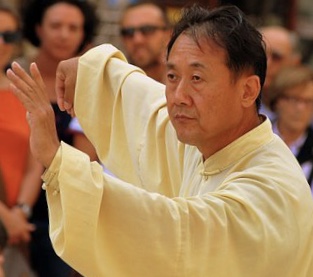Tai chi is described as meditation in motion and has proven mental and physical benefits. This ancient practice holds up well under the scrutiny of scientific study.
Harvard Medical School reports that Tai Chi supports the following physical aspects:
- balance
- coordination
- flexibility
- muscle strength
- stamina
- stress release and
- improved body awareness. [1]
This report goes on to say that people with physical conditions that cause pain, such as osteoarthritis, rheumatoid arthritis, fibromyalgia, and others, may be relieved by the regular practice of tai chi. [1]
The National Institutes of Health (NIH) has several reports that support these benefits for reducing pain and increasing flexibility for people who suffer from fibromyalgia and osteoarthritis in the knees and elsewhere in the body. [2] [3] [4] [5] [6]
The NIH has found statistically significant positive effects from tai chi on:
- balance
- reduction of falls
- hypertension
- cognitive performance
- obstructive pulmonary disease
- pain
- depression and
- muscle strength. [7] [8]
Although tai chi originated as a martial art form, it is usually taught in the US as a series of slow mindful movements coordinated with breathing. This combination of mindfulness, breathing and movement leads to;
- strengthening and stretching of muscles
- improved blood flow and
- body awareness. [7]
The New England Journal of Medicine has reported that tai chi can have positive effects on postural stability for people with mild-to-moderate Parkinson’s disease. [9]
People who may have any of these, or other physical conditions, should check with a doctor before starting any new type of physical exercise, even the gentle art of tai chi.
If you live in the Houston, Texas area, you may be happy to learn that the Thien Sinh Hoi Zenobics Society has been offering complimentary Zenobics tai chi classes to people in the community for over 30 years. This community service organization was founded by late Master Nguyen Cao Thanh and the classes are taught by volunteers. [10]
Thien Sinh Hoi Zenobics Society tai chi classes are held at the following locations:
- St. Vincent De Paul Family Center 6800 Buffalo Speedway Houston, TX 77025. Mondays 3:15-4:15 PM and 4:15-5:45 PM
- Bellaire Professional Building Lobby Atrium 6550 Mapleridge Rd Houston, Texas 77081 Mondays 6:00-7:30 PM
- Sharpstown Community Center 6600 Harbor Town Dr. Houston, TX 77036 Tuesdays 6:00-8:00 PM
- St. Anne Parish 2140 Westheimer Rd. Houston, TX 77098 Wednesdays 5:15-6:45 PM
Their new class season begins in September. For more information, you can contact them at ThienSinhHoiZenobicsSociety@USA.com
Tai chi can bring many positive physical, mental and spiritual benefits to people who practice the movements regularly.
Check out some of my other blog posts on natural ways to reduce pain and to fall asleep easily. You can also find more information on pain management and stress reduction on my website at http://www.soothehypnosis.com
[1] “Tai Chi and Chronic Pain,” Harvard Health Publications, Harvard Medical School, https://www.health.harvard.edu/alternative-and-complementary-medicine/tai-chi-and-chronic-pain (accessed August 2017)
[2] Wang C, Schmid CH, Rones R, Kalish R, Yinh J, Goldenberg DL, Lee Y, McAlindon A, “A Randomized Trial of Fibromyalgia,” US National Library of Medicine National Institutes of Health, https://www.ncbi.nlm.nih.gov/pubmed/20818876 (accessed August 2017)
[3] Jones KD1, Sherman CA, Mist SD, Carson JW, Bennett RM, Li F, “A randomized controlled trial of 8-form Tai chi improves symptoms and functional mobility in fibromyalgia patients,” US National Library of Medicine National Institutes of Health, https://www.ncbi.nlm.nih.gov/pubmed/20818876 (accessed August 2017)
[4] Lee MS1, Pittler MH, Ernst E, “Tai Chi for Osteoarthritis: a Systemic Review,” US National Library of Medicine National Institutes of Health, https://www.ncbi.nlm.nih.gov/pubmed/17874172 (accessed August 2017)
[5] Wang C1, Schmid CH, Hibberd PL, Kalish R, Roubenoff R, Rones R, McAlindon T, “Tai Chis is Effective in Treating Knee Osteoarthritis: a Randomized Controlled Trial,” US National Library of Medicine National Institutes of Health, https://www.ncbi.nlm.nih.gov/pubmed/19877092 (accessed August 2017)
[6] Hempel S, Taylor SL, Solloway MR, Miake-Lye IM, Beroes JM, Shanman R, Shekelle PG, “Evidence Map of Tai Chi,” US National Library of Medicine National Institutes of Health, https://www.ncbi.nlm.nih.gov/pubmed/25392900 (accessed August 2017)
[7] Hempel S, Taylor SL, Solloway MR, Miake-Lye IM, Beroes JM, Shanman R, Shekelle PG, “VA Evidence-based Synthesis Program Reports,” Washington (DC): Department of Veterans Affairs (US); 2014 Sep. https://www.ncbi.nlm.nih.gov/books/NBK49060/ (accessed August 2017)
[8] Wang X1,2, Pi Y3, Chen B1, Chen P1, Liu Y4, Wang R4, Li X1, Zhu Y5, Yang Y6, Niu Z4, “Effect of Traditional Chinese Exercise on the Quality of Life and Depression for Chronic Diseases: a Meta-analysis of Randomised Trials,” US National Library of Medicine, National Institutes of Health, https://www.ncbi.nlm.nih.gov/pubmed/26525282 (accessed August 2017)
[9] Fuzhong Li, Ph.D., Peter Harmer, Ph.D., M.P.H., Kathleen Fitzgerald, M.D., Elizabeth Eckstrom, M.D., M.P.H., Ronald Stock, M.D., Johnny Galver, P.T., Gianni Maddalozzo, Ph.D., and Sara S. Batya, M.D, “Tai Chi and Postural Stability in Patients with Parkinson’s Disease,” New England Journal of Medicine http://www.nejm.org/doi/full/10.1056/NEJMoa1107911#t=article%20 (accessed August 2017)
[10] Duc Q Nguyen, “Master Nguyen Cao Thanh,” Thiền Sinh Hội Zenobics Society, http://thiensinhhoi.org/en/founder.html (accessed August 2017)
[11] https://www.soothehypnosis.com/
Photo courtesy of pcdazero on Pixabay.
